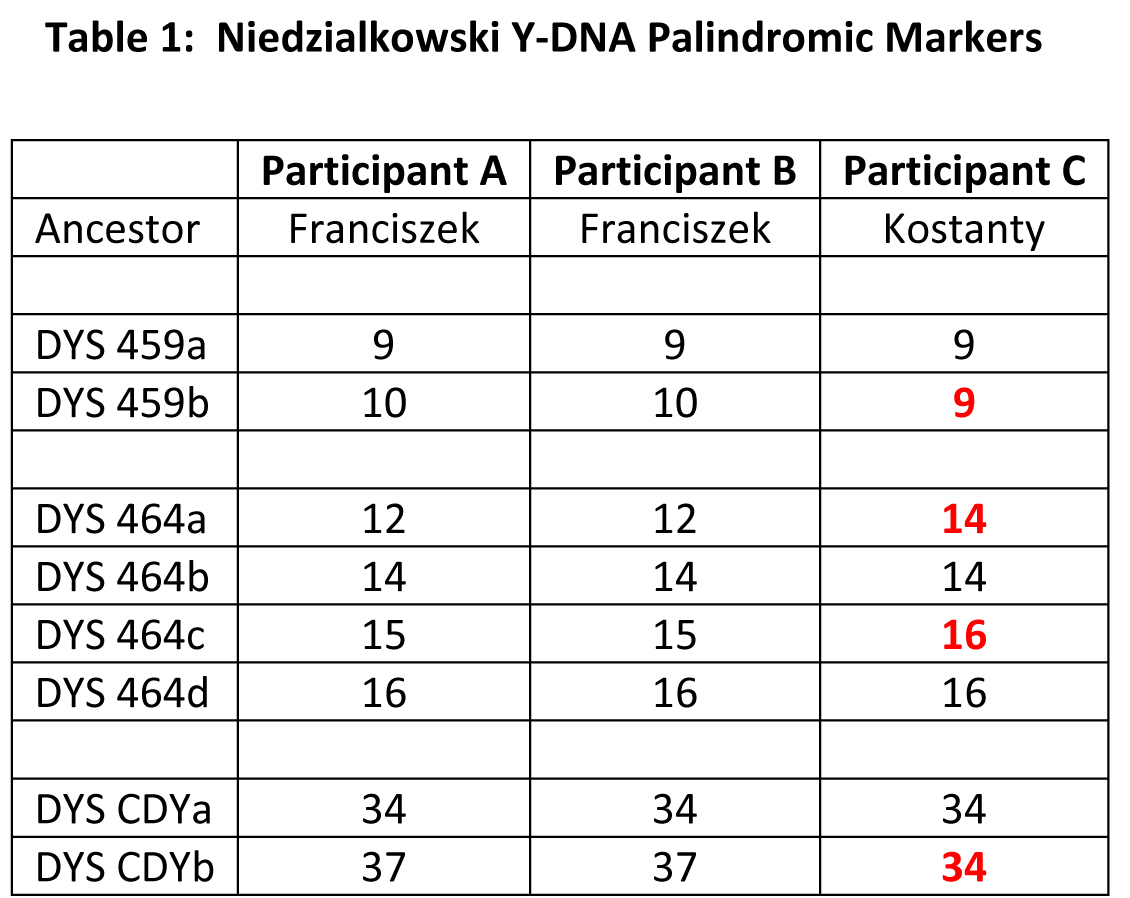INTRODUCTIONÂ
A Y-DNA study of three men was conducted in order to either support or disprove the proposed relationship between two Worcester County, Massachusetts families, one with the surname Niedzialkowski and the other with the surname Niedzialkoski.
The families of Franciszek Niedzialkoski and Kostanty Niedzialkowski have both lived in Worcester County, Massachusetts since the beginning of the 20th Century when both men immigrated from the Łomza Gubernia of the Congress Kingdom of Poland. Kostanty Niedzialkowski stated on his Immigrant Passenger Manifest that Franciszek Niedzialkoski was his uncle. However, the Polish baptismal, marriage, and death records necessary to confirm this relationship have not been located.
METHODS
Direct male descendants of both family lines agreed to participate in a Y-DNA study in order to test the proposed relationships. Two descendants of Franciszek (Participants A and B) and one descendant of Kostanty (Participant C) submitted DNA samples to Family Tree DNA for analysis of 67 Y-DNA markers.
Participants A and B are known to be first cousins. Participant C is thought to be a second cousin once removed of the other two. If the proposed relationships between the families are correct, the Y-DNA among the three should match very closely.
RESULTS
The results of the analysis of 67 markers on the Y chromosome show that Participants A and B each have a unique result at one marker . Participant A carries a one-step mutation at DYS 390, and Participant B carries a one-step mutation at DYS 444. Two differences out of sixty-seven for first cousins is a bit higher than usual, but not unexpected.
Participant C, however, shows four unique mutations: a one-step mutation at DYS 459b, a two-step mutation at DYS 464a, a one-step mutation at DYS 464c, and a three-step mutation at DYS CDYb . Considering all the differences between Particpant C and either Participant A or B, Family Tree DNA calculates the genetic difference between the two families as seven!
Kostanty’s family is clearly related to Franciszek’s family, but the relationship appears to be much more distant than previously thought. Based on these results, the probability that the two families share a common ancestor within 4 generations is only 3.3%.
Discussion of these results with representatives of Family Tree DNA at the recent Southern California Genealogy Jamboree revealed that all the mutations in the DNA of Participant C were at palindromic markers and that the mutations seemed to duplicate the number of repeats in homologous markers.
Analysis of the palindromic markers on the Y chromosome of the three participants is shown in Table 1. The variant results of Participant C are highlighted in red. The eight markers shown actually represent duplications of only three distinguishable markers, DYS 459, DYS 464, and DYS CDY . DYS 459 appears twice (DYS 459a and DYS 459b), DYS 464 appears four times (DYS 464a, DYS 464b, DYS 464c, and DYS 464d), and DYS CDY appears twice on the Y chromosome (DYS CDYa and DYS CDYb) in these participants.
All these markers appear on a Y chromosome palindromic region. Just as the bases A and T and the bases C and G form pairs in double-stranded DNA, the same bases form pairs in the palindromic regions of single-stranded DNA and consequently form structures that resemble hairpins.
An event called recombinational loss of heterozygosity (recLOH) can occur in these hairpin regions . If, during DNA replication, a section of DNA is accidentally deleted on one side of the hairpin, the cell will attempt to repair the deletion by copying the remaining side of the hairpin. Thus, half of the existing markers will be deleted and replaced with an exact duplicate of the remaining markers.
And that’s just what happened in the Y-DNA of Participant C. What appear at first glance to be mutations at four markers, for a total genetic distance of seven, is actually a single mutation with a genetic distance of one.
DISCUSSION
Because of the recLOH event in the Y chromosome of Participant C, it is now clear that all three participants are very closely related. Each participant demonstrates a single unique mutation that, in the future, can accurately identify which of these three branches of the Niedzialkowski/Niedzialkoski families a descendant belongs.
These results provide evidence that the proposed relationships between the families of Franciszek Niedzialkoski and Kostanty Niedzialkowski are correct, even in the absence of traditional genealogical evidence.
REFERENCES
Rosen, S., Skaletsky, H., Marszalek, J. D., Minx, P. J., Cordum, H. S., Waterstron, R. H., Wilson, R. K. & Page, D. C. Abundant gene conversion between arms of palindromes in human and ape Y chromosomes. Nature 423, 873-876 (2003).
Copyright © 2008 by Stephen J. Danko





Very interesting study! I’m sure the results of the DNA still aren’t curbing that itch to find records to confirm the relationships 🙂 Love the blog. Keep up the great work.